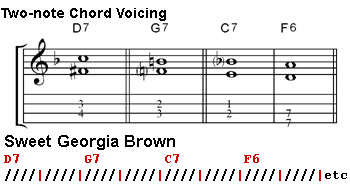« Listen up! |
Main
| Circle of Fifths Examples »
 August 19, 2006 | Two-Note Chords August 19, 2006 | Two-Note Chords
Jazzers can be guilty of making things too complicated. (Like this is news to you.) We can get so carried away with extended chords and complex voicings that sometimes our ears (and fingers!) beg for some simple variety...
We've made the plea for the purity of the Three-Note chord, but let's go a step farther and reduce things to two. We know that the two most import tones are the 3rd and 7th, assuming the root is already going on in another instrument, likely the lowest one or bass. Anything else, 9th, 11th, 13th is just icing on the cake.
Take a look at a potential fingering for comping on the tune "Sweet Georgia Brown." Here we strip away all but the 3rd and 7th of the first three chords, and listen how pure, yet complete this sounds:

Since it's a Circle of 5ths progression with a succession of Dominant 7ths, notice how little you have to move. Remember this trick; it's one you'll be able to repeat any time you have this in another key. By playing it this way, you have several benefits:
- No extended chord clashes. Somebody wants to play a #9, another wants a regular 9. You end up staying out of the way.
- Textural simplicity. Too many players slapping notes in the same register is hard to listen to, and can become harshly monotonous.
- Textural variety. The 29th chorus of comping on same song and you need to offer your audience (and your sanity) something different. Add these voicings to your bag of tricks.
You can offer more variation in the way you mute or choke these notes, too. Drive them 4 to a bar, accent the back beat, or just "chop" on the back beat. If everyone else is quiet enough, this will make the audience listen closer. (It's especially appropriate during a bass solo.)
Take it easy, once in a while.
Posted by Ted at August 19, 2006 9:25 PM

Disclaimer: In the 'Information Age' of the 21st Century,
any fool with a computer, a modem, and an idea can
become a self-professed 'expert." This site does not
come equipped with 'discernment.'
|



